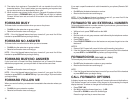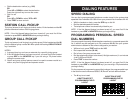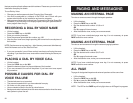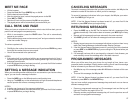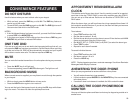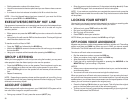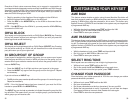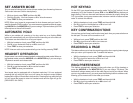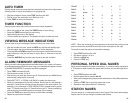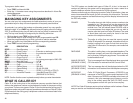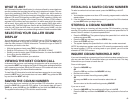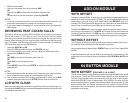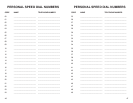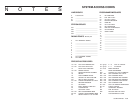To program a station name:
• Press TRSF and then dial 104.
• Enter the 11 character name using the procedure described in
Alarm Re-
minder Messages
.
• Press TRSF to store the name.
MANAGING KEY ASSIGNMENTS
You can view your key assignments and add extenders to some of your pro-
grammable keys for easy one touch operation of frequently used features.
An extender is a number that makes an otherwise general key very specific.
Adding the digit “4” to a PAGE key defines this key for paging zone four. Adding
“225” to a different pickup key will define this key as pickup for extension 225
only. The key must already be assigned by the installing technician.
• While on-hook, press TRSF and then dial 107.
• Use the VOL keys to scroll through all of your programmable keys OR
Press the programmable key to which you want to add the extender.
• When you reach a key listed below, dial the corresponding extender.
• Press TRSF to store and exit programming.
KEY DESCRIPTION EXTENDER
BOSS .............. Boss/Secretary ................1–4
DP ................... Direct Pickup....................Extension or station group number
DS ................... Direct Station ...................Any extension number
FWRD ..............Call Forwarding.................0–6
GPIK................ Group Pick-Up ..................01–20
IG .................... In/Out of Group ................Any group you are part of 500–529
MMPG ............. Meet Me Page ..................0–9, ✱
PSMG.............. Programmed Message .....01–20
PAGE............... Page.................................0–9, ✱
SG ................... Station Group ...................500–529
SPD .................Speed Dialing ...................00–49, 500–999
DIR .................. Directory ..........................PERS (1), SYS (2) or STN (3)
VT.................... Voice Mail Transfer ...........Voice Mail Group (501–529)
[RELEASE 3 & 4 ONLY]
NOTE: Confirm that the cursor is placed correctly before you enter the extender.
WHAT IS CALLER ID?
Caller ID is the name given to the telephone company-provided feature that
delivers the telephone number and sometimes the name of the person calling
your phone. There are two types of Caller ID; the first delivers the calling party’s
telephone number only and the second (sometimes referred to as “Deluxe” Caller
ID) delivers both the calling party’s telephone number and name as listed in the
telephone directory.
40
The DCS system can handle both types of Caller ID; in fact, in the case of
number only delivery, the system can be programmed to insert a name for a
specific telephone number (up to a maximum of 250 numbers).
However, even though you are paying to receive Caller ID information, there are
some circumstances that mean you will not receive this information. The three
most common reasons are listed below along with the display information that
the DCS will provide.
PRIVATE The caller does not wish his/her name or number to be
revealed to you. This type of call can be stopped at the
telephone company by dialing an access code on your
outside lines. This will redirect these PRIVATE calls to
an announcement that states that you do not wish to
receive calls that have had Caller ID blocked. The code
to block these calls can usually be found in the front
section of the telephone directory.
OUT OF AREA The caller is calling from an area that cannot provide
Caller ID information (for example, international calls) or
he/she is calling from a type of circuit that cannot pro-
vide Caller ID information, for example, some outbound
WATS lines.
PAYPHONE The caller is calling from a coin-operated telephone. The
telephone company will send this information as there
are no directory listings for pay phones. The number will
be delivered as usual.
INVALID CID INFO This is a message that will be displayed when corrupted
[RELEASE 4 ONLY] CID information is received from the Central Office.
NO CID RECEIVED This is a message that will be displayed when the CID
[RELEASE 4 ONLY] information is not received from the telephone company.
NO CID DSP Caller ID Digital Signal Processors (CIDDSP’s) are
[RELEASE 4 ONLY] resources in the DCS to receive and translate the CID
data. If there are no CIDDSPs available at the time a call
comes in, this is the message you will see on your dis-
play. In the unlikely event that [NO CID DSP] consis-
tently appears consult with your service company.
NOTE: The Caller ID features require optional software and/or hardware. Please
see your service and installation company for details.
41



